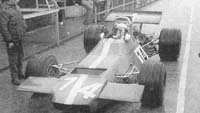JYS practising the De Tomaso
Author
- Mattijs Diepraam
Date
- 8W Autumn 2001 issue
Related articles
- De Tomaso - From Argentina to Italy to Grand Prix racing, by Mattijs Diepraam
- Piers Courage - Heir to an empire, cash-strapped natural, by Mattijs Diepraam
- Jackie Stewart - The organiser, by Mattijs Diepraam
Who?Jackie Stewart What?De Tomaso-Cosworth 505-38 Where?Silverstone When?Friday practice for the 1970 International Trophy (April 25, 1970) |
 |
Why?
You don't see Michael Schumacher getting into a Jordan for a short spin during Australian GP practice - just to try it out for size, and for fun? Granted, he did test a Sauber a couple of years ago but that was during a Mugello test session, for a team that ran Ferrari engines. With the more than imaginary risk of knowledge leaking to rival outfits "guest drives" during an important motor racing event are completely unthinkable these days.
However, it wasn't so uncommon a few decades ago. Stirling Moss used to relish the opportunity to test someone else's car during a racing weekend - think of his Scarab drive in practice for 1960 Monaco GP or giving Beaufort's Maarsbergen Porsche a go in preparation for the 1959 Dutch GP - and over thirty years ago Jackie Stewart, the reigning World Champion volunteered to practice Frank Williams' De Tomaso 505-38 for the 1970 International Trophy while regular driver Piers Courage was still in at work in Italy in the Monza 1000kms. Further to that, former British F3 star Roy Pike drove the car in Saturday's wet practice, setting a time of 2.07.4, which compares with Amon's pole time of 1.21.4 and the times of the three slowest qualifiers: Kaye Griffiths in an F5000 Lola T142 (1.40.3), John Miles in the Lotus 72 (1.45.9) and later C2 World Champion Gordon Spice in the peculiar Kitchener K3A (1.53.4). And here's a picture of that completely unknown machine!
On Sunday, Courage was back in time for the race, with Stewart switching to his usual Tyrrell-run March. Stewart's time in the car can't be seen as a competitive attempt, as Courage started the race from the back of the grid with no time before climbing up to the order to take a fighting and competitive third. It would be the car's best result.
De Tomaso's return to F1 was prompted by a modest comeback to motor racing in 1969, when Alejandro took an interest in the Argentinian First Championship, run to F2-style regulations. The winter series was based on production engines up to 1.6 litres and consisted of four rounds at Buenos Aires, Cordoba, San Juan and Buenos Aires again. There was a lot of overseas interest from the European F2 runners, and the likes of Jochen Rindt, Jean-Pierre Beltoise, Jo Siffert, Carlos Reutemann, Clay Regazzoni and Alan Rees all took part in Ferraris, Matras, Lotuses and Brabhams. Winner of the last round was Piers Courage in a Williams-run Brabham, the Englishman that would become the 1970 De Tomaso F1 driver.
The De Tomaso 103 F2 car was designed by a young Giampaolo Dallara, who one year later was also responsible for the F1 car. It debuted in the Monza Lotteria race at the hands of ex-Ferrari racer Jonathan Williams, qualifying last but taking 9th place in the final results, ahead of Werner Lindermann's Brabham. In the Austrian airfield race at Tulln Williams was a non-classified finisher, 9 laps down. Graded driver Jacky Ickx then drove the car at Enna in the Mediterrenean GP in August, retiring with an engine failure. Courage took over for the Rome GP at Vallelunga, round 7 of the European championship, finishing an amazing 3rd - unlapped - in the first heat (also due to two multi-car pile-ups taking out several top drivers) before retiring with a misfire in the second heat. The achievement must have inspired De Tomaso into signing Piers for his F1 effort. Williams then continued to drive the car in the Argentinian winter championship, an 11th place at Cordoba its best result.
Contrary to earlier De Tomaso single-seaters, the 103 racer was a simple kit-car design, not using proprietary De Tomaso power, as the miserable F1 cars of the early sixties had done, but a Cosworth FVA engine and a Hewland FT gearbox. With it, Alejandro de Tomaso remarkably kept away from De Tomaso tradition and followed the British garagiste line. He also went on to hire a professional team manager and foreign drivers, perhaps inspired by Ford's involvement in the Pantera project.
By the look of De Tomaso's meagre F2 results a step up to F1 seemed a bit too ambitious but the skill and enthousiasm of Frank Williams and Piers Courage helped the marque's F1 comeback not to become another disgrace. At Kyalami, Courage hit a stone and damaged the suspension, asking for a complete rebuild in time for the Spanish GP at Jarama, where Piers hit the guardrail after qualifying 19th, wiping the car out. The week after was the International Trophy, with Stewart subbing for Piers during practice, with the Englishman taking third in two heats on race day.
Buoyed by the result the team had high hopes for Monaco and Belgium but the two events brought nothing. This left Courage particularly eager to put down a good result at Zandvoort, where it all went horribly wrong. The team suffered a huge blow and were absent at the French GP. Courage's replacements Brian Redman and Tim Schenken failed to make waves in the remaining events, probably aided by the team's lack of inspiration. The team didn't even bother to show up in Mexico.
The Zandvoort tragedy spelled the end for De Tomaso's single-seater involvement, for the F2 team was also abandoned after a no-show for Courage at Zolder.
